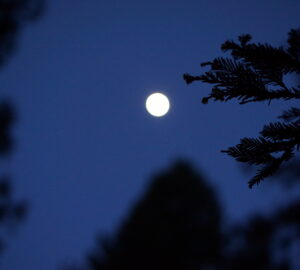Pack returns to national forest after a century
In a remarkable chance encounter hundreds of miles from any other known wolves, two of the canids recently found each other in Sequoia National Forest, where their kind has been absent since the 1920s. Researchers are studying how this breeding pair, now part of the Yowlumni pack, and California’s other 42 known wolves are impacting the ecosystems.
The Yowlumni pack breeding male is from the Lassen Pack in Northern California. The Yowlumni pack breeding female is from the Rogue Pack in southwestern Oregon. She is possibly one of the last offspring of the wolf called OR-7, who earned fame for his wanderings across Oregon and beyond. The Yowlumni pack breeding pair was discovered last summer, after they’d produced a litter of six pups.
“This pack surprised us,” says Axel Hunnicutt, state gray wolf coordinator at California Department of Fish and Wildlife. “We were expecting wolf packs to continue forming south down the Sierra Nevada gradually.”
Staying put
Though wolves may wander months or even years in search of a mate, once they pair up, they tend to stay exactly where they find each other, says Hunnicutt. It’s likely that each wolf journeyed independently across the Sierra Nevada until they crossed paths in what Hunnicutt calls “one of nature’s great needle-in-a-haystack love stories.”
After the pack was discovered near their reservation and ancestral lands, the Tule River Tribe of California partnered with CDFW to name the pack after the Yowlumni band of Tule River Yokuts.
The wolves use about 300 square miles in Sequoia National Forest, which showcases nearly half of the giant sequoia groves in the world and many of the largest trees. It’s a diverse landscape in the Sierra Nevada of Southern California, with cloud-catching peaks, roaring waterfalls, and a mosaic of forests.
A possible shift among carnivores
Wolves are an apex, or “top” predator and eat mostly ungulates like deer and elks. Their presence could prompt other carnivores such as mountain lions and black bears to shift their diets slightly, says Hunnicutt. “The Yowlumni pack is the first in the south Sierra, a different ecosystem than that of all other known wolf packs up north, and we’re interested to see how they will interact with other wildlife in that system,” Hunnicutt says. It’s the first time wolves are inhabiting an area with large numbers of wild pigs, which can spread invasive plants and hog resources like acorns from other wildlife. “This native carnivore coming back could potentially have a positive effect by utilizing this nonnative species,” says Hunnicutt.
Wolves’ impact on Yellowstone National Park has been well documented since they were first reintroduced there in 1995. How wolves affect ecosystems outside of national parks is not nearly as well studied. CDFW and University of California, Berkeley, are teaming up to study the state’s wolves and learn more about the ecological niches these canids are filling.
Tracking the pack
Last December, biologists captured YOW01F, the Yowlumni pack’s breeding female, and fitted her with a GPS collar so they can better track the pack. Wolves breed around Valentine’s Day; once YOW01F and her next litter vacate their den, biologists can sample scat near the entrance and obtain a genetic profile for each pup, which will allow them to identify the wolves no matter where they go.
Hunnicutt expects them to stay in the mountains, where they can find abundant prey and better avoid people, but, like so many wolves before them, they could pop up in “interesting places,” Hunnicutt says. “Wolves always surprise us.”


One Response to “How new wolves may affect the sequoia ecosystem”
Lee
Please advocate for effective deterrence of hunters who claim they thought it was a Coyote or brutally trapped/poisoned. Thank you for a delightful video.